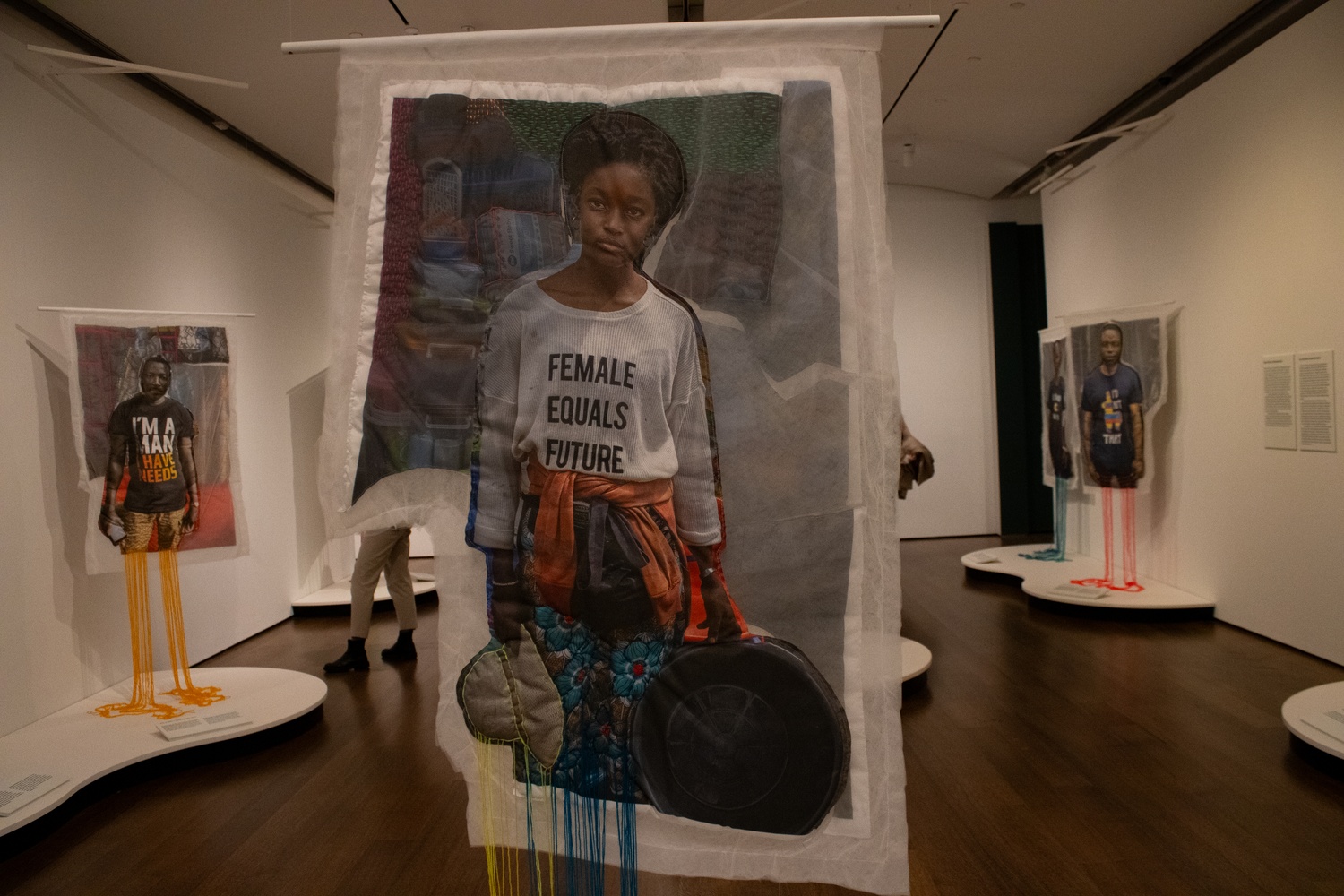
News
News Flash: Memory Shop and Anime Zakka to Open in Harvard Square

News
Harvard Researchers Develop AI-Driven Framework To Study Social Interactions, A Step Forward for Autism Research

News
Harvard Innovation Labs Announces 25 President’s Innovation Challenge Finalists

News
Graduate Student Council To Vote on Meeting Attendance Policy

News
Pop Hits and Politics: At Yardfest, Students Dance to Bedingfield and a Student Band Condemns Trump
‘Joana Choumali: Languages of West African Marketplaces’ Review: A Poignant Question Between the Threads of Fast Fashion

When walking into the “Languages of West African Marketplaces” exhibit located in the University Research Gallery at the Harvard Art Museums, the bright thread of the exhibit quickly jumps out against the blank white walls of the museum. As the visitor steps closer, the somewhat 3D images of the characters create an uncanny effect that pulls them in even further. Each of the 12 life-size photographic tapestries features a composite portrait of a person, meticulously hand-quilted and embroidered. The portraits are overlaid with a layer of tulle and show the subjects wearing shirts printed with English-language slogans. The portrait begins as a full-body image but abruptly stops at the knee, changing into pieces of bright thread.
This exhibit was created by Joana Choumali, an accomplished artist and recipient of the 2020 Robert Gardner Photography Fellowship at the Peabody Museum, in collaboration with the Harvard Art Museums. Choumali’s work largely focuses on Africa, using a unique blend of textiles and colors, and has appeared at the Museum of Civilizations, the Dowhali Foundation for Contemporary Arts, the Rotonde des Arts, and Palais de la Culture.
This exhibition is especially close to home for Choumali, who was born in Abidjan, Côte d’Ivoire, and uses the markets there and in Ghana as inspiration for the work. In many West African port cities, people purchase secondhand fast fashion items discarded by the United States and Europe, and although these clothes are widely worn, many of the wearers do not understand the prominent English text or jokes printed on them because of their lack of English proficiency.
During visits to the market, and with the help of translators, Choumali explained the meanings of the English phrases on participants’ shirts. She then asked them how they felt about the messages they were unknowingly wearing. Many of the messages on the shirts convey suggestive meanings and reflect gendered language. Many participants admitted they didn’t understand the innuendos. Several expressed a preference for wearing locally made cultural clothing instead. Still, the common thread was that personal feelings mattered less than affordability, and the low cost ultimately outweighed everything else. This creates a power dissonance between the wants of the wearers and their inability to express themselves in clothing, a powerful reflection on capitalism and its effects.
In her artistic process, Choumali begins by creating a background with snippets of the scenes from the market and overlays the background with tulle, creating a foggy, hazy effect. The portrait shows a person standing in stark contrast to the background, their image gradually dissolving into colorful threads just below the knees. In their eyes, the visitor sees more than a portrait, they see sparks of real lives that invite quiet questions.
There’s an emotional pull in the images, a sense of real connection. But the twist? None of the people are real. Choumali scans the photographs of real people, does a skin color analysis, and then creates a new image with snippets of old faces. While each person feels undeniably real, the visitor is actually seeing a completely manufactured fictional face. This is an extremely bold and rare choice. It raises a subtle ethical dilemma: The full body and name of each person are displayed, leaving no anonymity, yet they aren’t given credit. Is it ethical to represent someone so completely without acknowledgment? There is no clear or easy answer to the question, leaving the visitor with another challenging question.
Overall, the exhibit not only showcases unique and compelling artistic forms but also invites the viewer to engage with thought-provoking, critical questions. It is an insightful critique of fast fashion and its global impact. There is an extreme attention to detail from the artist, with every rough seam of the tulle, the careful choice of the background, and the way the threads at the bottom of the portraits are arranged. This exhibit is a one-of-a-kind experience that makes one challenge the complex stories that may lie between pieces of thread, both about the individual and larger society.
“Joana Choumali: Languages of West African Marketplaces” can be seen on display at the Harvard Art Museums until May 11 in the University Research Gallery.
—Staff writer Ava E. Silva can be reached at ava.silva@thecrimson.com.
Want to keep up with breaking news? Subscribe to our email newsletter.
Most Read
- Harvard Sues Trump Administration Over $2.2 Billion Funding Freeze
- Trump To Cut Another $1 Billion From Harvard Health Research Funding, Wall Street Journal Reports
- Harvard School of Public Health Begins Layoffs As Trump Slashes Funding
- Harvard, Clean Up Your Mess
- Read Harvard’s Complaint Against the Trump Administration.
From Our Advertisers






HUSL seeks to create and empower a community of students who are seeking pathways into the Sports Business Industry.
